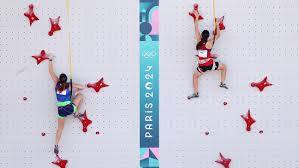Introduction
Sport Climbing Combined Olympics: Sport climbing made its much-anticipated debut at the 2020 Tokyo Olympics, introducing the world to the adrenaline-pumping combined format. This event is significant as it combines three distinct climbing disciplines: speed, bouldering, and lead. In this article, we’ll dive deep into the nuances of sport climbing combined, its history, the rules, and its impact on the climbing community.
History of Sport Climbing Combined Olympics
Sport Climbing Combined Olympics Origins and Evolution
Sport climbing has roots that trace back to the early days of mountaineering, but it began to take shape as a distinct sport in the 1980s. Initially, it was a way for climbers to train in a safer environment, focusing on the physical and technical aspects without the risks associated with traditional rock climbing.
Sport Climbing Combined Olympics Before the Olympics
Before its inclusion in the Olympics, sport climbing was already popular in various international competitions such as the International Federation of Sport Climbing (IFSC) World Cup and World Championships. These events helped shape the format and rules that would eventually be used in the Olympics.
Inclusion in the Sport Climbing Combined Olympics
Road to Inclusion
The journey to the Olympics was not straightforward. It involved persistent efforts by the climbing community and governing bodies to showcase the sport’s appeal and global reach. The push for inclusion gained momentum in the 2010s, culminating in the International Olympic Committee’s (IOC) announcement in 2016 that sport climbing would be featured in the 2020 Tokyo Olympics.
Debut in the 2020 Tokyo Sport Climbing Combined Olympics
Sport climbing’s debut in Tokyo was a historic moment. The combined format, which tests athletes across speed, bouldering, and lead, was chosen to represent the sport. This decision aimed to highlight the versatility and all-around abilities of the climbers.
Understanding the Sport Climbing Combined Olympics
Explanation of the Combined Event
The combined format is unique in that it requires climbers to compete in all three disciplines: speed, bouldering, and lead. Scores from each discipline are multiplied together, and the athlete with the lowest combined score wins.
Three Disciplines: Speed, Bouldering, and Lead
- Speed Climbing: Climbers race up a 15-meter wall set with identical routes, aiming for the fastest time.
- Bouldering: Climbers solve short, complex climbing problems (known as “boulders”) on a 4.5-meter wall without ropes.
- Lead Climbing: Climbers attempt to climb as high as possible on a 15-meter wall within a fixed time, using a rope for protection.
Speed Climbing
Rules and Scoring
In speed climbing, two climbers race side-by-side on identical routes. The fastest climber wins the round, and times are recorded to determine rankings.
Techniques and Strategies Of Sport Climbing Combined Olympics
Speed climbing is all about efficiency and explosive power. Climbers develop specialized techniques to minimize movement and maximize speed, often memorizing the route to perfection.
Bouldering
Rules and Scoring of Sport Climbing Combined Olympics
In bouldering, climbers attempt to complete several boulder problems within a set time. Each problem has a “zone” hold and a “top” hold, with points awarded based on how high the climber gets.
Techniques and Strategies Of Sport Climbing Combined Olympics
Bouldering requires a mix of strength, technique, and problem-solving skills. Climbers must analyze each problem, often attempting multiple strategies to find the best solution.
Lead Climbing
Rules and Scoring Of Sport Climbing Combined Olympics
In lead climbing, climbers have a set time to climb as high as possible on a long route. Points are awarded based on the height reached, with additional points for securing clips along the way.
Techniques and Strategies Of Sport Climbing Combined Olympics
Lead climbing combines endurance, technical skill, and mental fortitude. Climbers must manage their energy, plan their moves, and remain calm under pressure to succeed.
Training for Combined Events
Physical Preparation For Sport Climbing Combined Olympics
Training for the combined event is incredibly demanding, requiring a balance of speed, power, and endurance. Climbers often train each discipline separately while incorporating cross-training to build overall fitness.
Mental Preparation
Mental toughness is crucial in sport climbing. Athletes use visualization techniques, mindfulness, and mental conditioning to prepare for the high-stress competition environment.
Key Athletes in Sport Climbing Combined Olympics
Notable Competitors in Tokyo 2020
The Tokyo Olympics saw standout performances from athletes like Janja Garnbret of Slovenia, who dominated the women’s competition, and Alberto Ginés López of Spain, who clinched gold in the men’s event.
Rising Stars
The future of sport climbing is bright, with young athletes like Colin Duffy from the USA and Laura Rogora from Italy showing great promise and potential for future Olympic success.
Challenges and Controversies
Balancing Three Disciplines
One of the main challenges of the combined format is the need for climbers to excel in all three disciplines, which require different skill sets. This balancing act has been a point of contention among athletes and fans alike.
Criticisms of the Combined Format
Some critics argue that the combined format does not fully represent the diversity of sport climbing. They advocate for separate medals for each discipline to better showcase the athletes’ specialized skills.
Spectator’s Guide
How to Watch and Understand the Events
For new viewers, Sport Climbing Combined Olympics understanding the combined format can be challenging. Each discipline has its own rules and scoring, but the overall goal is to achieve the lowest combined score. Watching how climbers tackle different problems and routes can be incredibly exciting.
Key Moments to Look For
Key moments in sport climbing include lightning-fast speed climbing runs, the creative problem-solving in bouldering, and the endurance challenges in lead climbing. Each discipline offers its own set of thrilling highlights.
Impact of the Olympics on Sport Climbing
Popularity Surge
The inclusion of Sport Climbing Combined Olympics has significantly boosted its popularity, drawing new fans and participants worldwide. Climbing gyms have seen increased memberships, and more people are discovering the joys of climbing.
Growth of the Sport Worldwide
With its Olympic debut, Sport Climbing Combined Olympics has seen a surge in international interest and investment. Countries are developing climbing programs, and new competitions are being organized to nurture emerging talent.
Future of Sport Climbing Combined Olympics
Changes for Paris 2024
For the Paris 2024 Olympics, the format will be adjusted to include separate events for speed climbing and a combined event for bouldering and lead climbing. This change aims to address some criticisms and better represent the sport.
Potential Developments Beyond 2024
Looking beyond Paris 2024, there is potential for further changes and additions to the Olympic sport climbing events. These may include separate medals for each discipline or the inclusion of new climbing formats.
Personal Stories
Inspiring Journeys of Olympians
Many Olympians have inspiring stories of overcoming obstacles to reach the top of their sport. From battling injuries to training in challenging conditions, these athletes’ journeys are a testament to their dedication and passion.
Overcoming Obstacles
Climbers often face significant challenges, both physical and mental. Their stories of resilience and perseverance can inspire others to pursue their own goals, whether in climbing or other aspects of life.
Read More Indiana MyLF Net Worth: Exploring the Financial Landscape of a Rising Star
Conclusion
Sport Climbing Combined Olympics inclusion in the Olympics has been a game-changer for the sport. The combined format, despite its challenges, showcases the incredible versatility and skill of the athletes. As the sport continues to grow and evolve, its future in the Olympics looks promising, with exciting changes and developments on the horizon.








